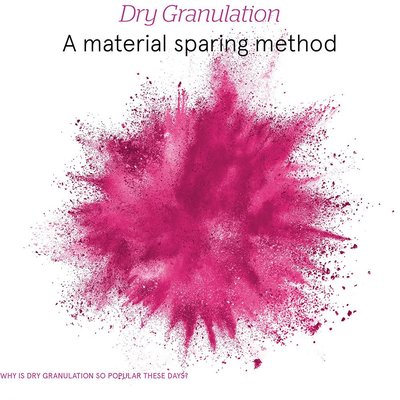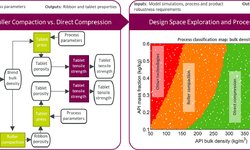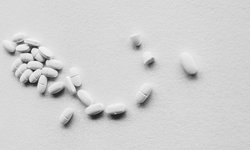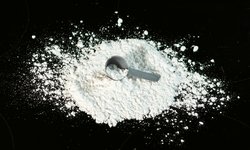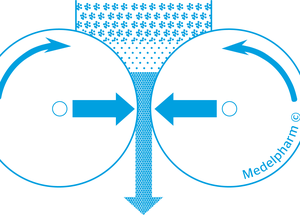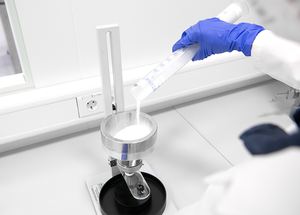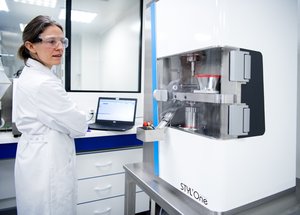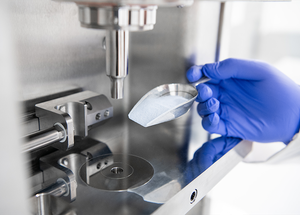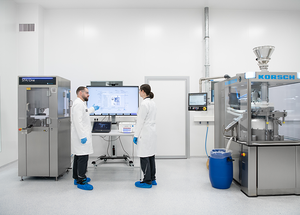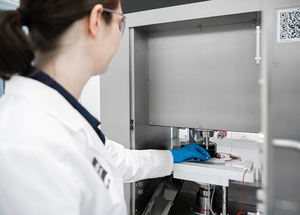WHY IS DRY GRANULATION SO POPULAR THESE DAYS?
Granulation of pharmaceutical powder is often required to prevent segregation of the Active Pharmaceutical Ingredient (API) and/or to enhance the blend flowability, which is critical to ensure consistent tablet mass (weight) on rotary tablet presses. Dry granulation has been known for decades. The main benefit is a lower cost of operation compared to wet granulation. But most interestingly, it’s much easier to contain a roller compactor to process high potent drugs. It’s also a truly continuous process, which is a big trend these days. One have to point out that in the past decade, equipment manufacturers have introduced more instrumentation and advanced control systems, such as Gerteis or LB Bohle to name a few, allowing a more consistent density on the ribbons through a gap control loop system.

WHICH SOLUTIONS EXIST TODAY TO SCREEN FORMULATIONS FOR THEIR SUITABILITY TO DRY GRANULATION?
Formulation scientists have to screen several formula to ensure proper Quality Attributes, such as tablet breaking force, disintegration time and dissolution profiles. R&D roller compactors have usually large rolls, which means that the required quantity of API to run a test is fairly high, a main hurdle at early stage when API is not available in large quantity, not to mention the cost per kilo. One solution could have been to use roller compactor with small rolls to use smaller quantity of material. However, these small rolls cannot mimic the densification factor of large rolls used in production and this can yield to false negatives. That’s the reason why people are looked for alternative methods to assess the feasibility of dry granulation at early stage of the development.

CAN YOU DESCRIBE IN MORE DETAILS THIS MATERIAL SPARING METHOD?
This method was introduced back in 2004 in a publication from Pfizer [1] in the USA. Their proof of concept was to show that density-pressure plots were identical between compacts made on a single punch press and ribbons made on real roller compactor. Both punches on the single punch press, a “compaction simulator” to be precise, was following a sinewave path to mimic the compression dynamics occurring between the rolls of roller compactors. The rolls diameter and rolls speed were taken into account to be as close as possible from the real process. The first Quality Attribute is the relative density, also called solid fraction, and is calculated by dividing the density by the powder true density, a parameter generally measured with a helium pycnometer.

The other Quality Attribute is the pressure, which is not directly comparable between a single punch press and a roller compactor. For this purpose, Pfizer just manually fitted the compressibility curves together to have a correlation between the pressures on both equipment.
HOW DO YOU PROVE THAT THIS METHOD GIVES SIMILAR RESULTS AS ON A ROLLER COMPACTOR?
First, like any material-sparing methods, mimicking the dry granulation process on a single punch press has some limitations. The feeding system, de-aeration, pressure gradient along the ribbon width, the roll surface and shape are actually not taken into account. That’s sounds like a lot, but this method is actually the only method to evaluate the dry granulation process at early stages.
With the STYL'One compaction simulator, this method was improved by implementing a mathematical model to compute, from the pressure measured on the STYL’One, the equivalent hydraulic pressure (or specific compaction force) that should be entered on a roller compactor to reach the same solid fraction. This method is called hybrid modelling, since it uses a mathematical model combined with real compacts made on a single punch press. Recently, Professor Peter Kleinbudde from the University of Düsseldorf published a paper [2] using different excipients (brittle, plastic). They’ve shown that compacts, called ribblets (a neologism created from ribbon+tablet) made on a STYL’One and ribbons made on a Gerteis roller compactor had similar relative density.
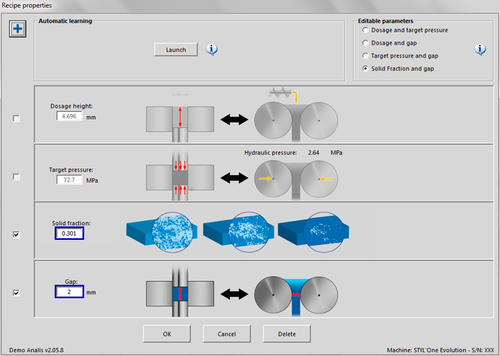
Even with the limitations listed earlier, this material-sparing method remains the most effective method available to assess dry granulation with a small amount of material. It has been adopted by pharmaceutical companies across the globe as one of their reference method to decide if dry granulation is a feasible process and to speed up their design of experiments when scaling-up to a commercial-size roller compactor.
WHAT ARE THE BENEFITS OF USING STYL’ONE TABLETING INSTRUMENT TO ASSESS A DRY GRANULATION PROJECT?
The philosophy of STYL’One is to help formulation scientists to easily implement this method, which is available in the software controlling the press. The formulator can choose from a library of branded roller compactors, such as Gerteis, LB Bohle, FitzPatrick, Alexanderwerk, Vector-Freund, Hosokawa Bepex,... Each profile bears all the physical characteristics: roll diameter and width, roll speed, gap range, specific compaction force or hydraulic pressure. Ribblets can be produced at a desired thickness (gap) and pressure.
If the True Density is known, the operator can simply select a desired Solid Fraction, typically between 0.6 and 0.8, and a thickness (gap) and STYL’One make the ribblets within specifications. The key benefits of this method is the use of extremely small quantity of API at early stage of the development. The formulator can design a small DoE with, let’s say, 3 solid fractions and different formulations.
Then, make a few ribblets, mill them to obtain dry granules, and recompress them into tablets, which can be characterized with tablet breaking force, disintegration time and dissolution profiles. All of this will help the selection of the right formulation. This method does not prevent the scale-up to a real roller compactor, which is absolutely necessary. It just allows to select the most adequate formulation and gives good approximation of the process parameters to be used on the roller compactor to achieve the desired Quality Attributes.

the author


